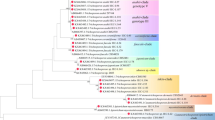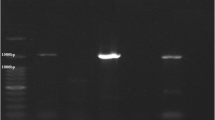Abstract
To characterize possible Trichophyton rubrum phenotypes, which circulate in two Brazilian localities, we tested 53 isolates of this dermatophyte for their ability to assimilate several carbon sources, for keratinase, proteinase, phospholipase, lipase and desoxiribonuclease (DNase) secretions, and for their susceptibility to the antifungals fluconazole, ketoconazole and itraconazole. For each method, the isolates were submitted to similarity analysis and the methods were evaluated for their discriminatory indexes. None of the isolates were capable of assimilating arabinose, dulcitol, lactose, melibiose, ribose and xylose, while all of the isolates assimilated maltose, sucrose and sorbitol. However, adonitol, cellobiose, dextrin, erythritol, fructose, galactose, inulin, mannitol, mannose, raffinose, rhamnose and trehalose were assimilated by some isolates but not by others. All isolates secreted keratinase and DNase, while none secreted phospholipase. Proteinase and lipase were secreted only by some isolates. All but four isolates were resistant to fluconazole, most of them were sensitive to ketoconazole and all were sensitive to itraconazole. Carbohydrate assimilation was the method that presented the highest discriminatory index, and also the method that displayed the largest number of biotypes. Taken together, these data suggest that significant phenotypic variations exist among T. rubrum isolates. They seem to occur independently from their geographic origins.
Similar content being viewed by others
References
Rippon JW. The changing epidemiology and emerging patterns of dermatophyte species. Curr Top Med Mycol 1985; 1: 209–234.
Rebell G, Taplin D. Dermatophytes – Their Recognition andId enti.cation, Miami: University of Miami Press, 1970, 123 pp.
English MP. Variation in Trichophyton rubrum as seen in a routine diagnostic service. Sabouraudia 1964; 3: 205–210.
Szilagyi G, Reiss F. Trichophyton rubrum (Castellani) var. flava and var. nova: a yellow pigment forming Trichophyton rubrum. Mycopathol Mycol Appl 1968; 36: 193–198.
Young CN. Range of variation among isolates of Trichophyton rubrum. Sabouraudia 1972; 10: 164–170.
Mehta JP, Deodhar KP, Chaphekar PM. Variation in Trichophyton rubrum. Mycologia 1978; 70: 847–849.
Philpot CM. The use of nutritional tests for di.erentiation of dermatophytes. Sabouraudia 1977; 15: 141–150.
Nobre G, Viegas MP. Lipolytic activity of dermatophytes. Mycopathol Mycol Appl 1972; 46: 319–323.
Hellgren L, Vincent J. Lipolytic activity of some dermatophytes. J MedMicrobiol 1980; 13: 155–157.
Skorepová M, Hauck H. Extracellular proteinases of Trichophyton rubrum andthe clinical pictures of tinea. Mykosen 1987; 30: 25–27.
Lopez-Martinez R, Manzano GP, Mier T, Mendez TLJ, Hernandez HF. Exoenzymes of dermatophytes isolatedfrom acute and chronic tinea. Rev Latinoam Microbiol 1994; 36: 17–20.
Granade TC, Artis WM. Antimycotic susceptibility testing of dermatophytes in microcultures with a standardized fragmented mycelial inoculum. Antimicrobial Agents Chemother 1980; 17: 725–729.
Oyeka CA, Gugnani HC. In vitro activity of seven azole compounds against some clinical isolates of non-dermatophytic flamentous fungi and some dermatophytes. Mycopathologia 1990; 110: 157–161.
Korting HC, Ollert M, Abeck D, and the German Collaborative dermatophyte drug susceptibility study group. Results of German multicenter study of antimicrobial susceptibilities of Trichophyton rubrum and Trichophyton mentagrophytes strains causing tinea unguium. Antimicrobial Agents Chemother 1995; 39: 1206–1208.
Niewerth M, Splanemann V, Korting HC, Ring J, Aeck D. Antimicrobial susceptibility testing of dermatophytes comparison of the agar macrodilution and broth microdilution tests. Chemotherapy 1998; 44: 31–35.
Grüsek E, Abeck D, Ring J. Relapsing severe Trichophyton rubrum infections in an immunocompromised host: Evidence of onychomycosis as a source of reinfection basedon lectin typing. Mycoses 1993; 36: 275–278.
Siesenop U, Böhm KH. Comparative studies on keratinase production of Trichophyton mentagrophytes strains of animal origin. Mycoses 1995; 38: 205–209.
Rüchel R, Tegeler R, Trost MA. A comparison of secretory proteinases from di.erent strains of Candida albicans. Sabouraudia 1982; 20: 233–234.
Price MF, Wilkinson ID, Gentry LO. Plate methodfor detection of phospholipase in Candida albicans. Sabouraudia 1982; 20: 7–14.
Muhsin TM, Aubaid AH, Al-Duboon AH. Extracellular enzyme activities of dermatophytes and yeast isolates on solid media. Mycoses 1997; 40: 465–469.
Dos Santos JI, Paula CR, Viani FC, Gambale W. Susceptibility testing of Trichophyton rubrum and Microsporum canis to three azole antifungals by E-test. J Mycol Med 2001; 11: 42–43.
Shepherd GJ. FITOPAC 1. Manual do usuário, Campinas: UNICAMP, 1994.
Hunter PR, Gaston MA. Numerical index of the discriminatory ability of typing systems: An application of Simpson's index of diversity. J Clin Microbiol 1988; 26: 2465–2466.
Meevootisom V, Niederpruem DJ. Control of exocellular proteases in dermatophytes and specially Trichophyton rubrum. Sabouraudia 1979; 17: 91–106.
Apodaca G, Mckerrow, JH. Regulation of Trichophyton rubrum proteolytic activity. Infec Immun 1989; 57: 3081–3090.
Apodaca G, Mckerrow JH. Expression of proteolytic activity by cultures of Trichophyton rubrum. J MedVet Mycol 1990; 28: 159–171.
Samdami AJ, Dykes PJ, Marks R. The proteolytic activity of strains of Trichophyton mentagrophytes and Trichophyton rubrum isolatedfrom tinea pedis andtinea unguium infections. J MedVet Mycol 1995; 33: 167–170.
Warnock DW, Speller DCE, Day JK, Farrel AJ. Resistogram methodfor di.erentiation of strains of Candida albicans. J Appl Bacteriol 1979; 46: 571–578.
Johnson EM, Davey KG, Szekeley A, Warnock DW. Itraconazole susceptibilities of fluconazole susceptible and resistant isolates of five Candida species. J Antimicrob Chemother 1995; 36: 787–793.
Bradley MC, Leidich S, Isham N, Elewski BE, Ghannoum MA. Antifungal susceptibilities andgenetic relatedness of serial Trichophyton rubrum isolates from patients with onychomycosis of the toe nail. Mycoses 1999; 42(Suppl. 2): 105–110.
Gräser Y, Kähnisc, J, Presber W. Molecular markers reveal exclusively clonal reproduction in Trichophyton rubrum. J Clin Microbiol 1999; 37: 3713–3717.
Author information
Authors and Affiliations
Rights and permissions
About this article
Cite this article
Dos Santos, J., Vicente, E., Paula, C. et al. Phenotypic Characterization of Trichophyton rubrum isolates from two geographic locations in Brazil. Eur J Epidemiol 17, 729–735 (2001). https://doi.org/10.1023/A:1015675728486
Issue Date:
DOI: https://doi.org/10.1023/A:1015675728486




